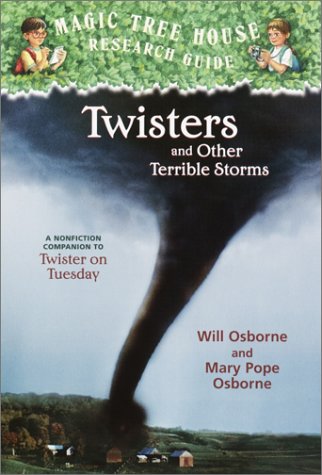“In May, a twister tears through Texas. It picks up whole houses and smashed them into the ground. In August, a hurricane rages for three days in Florida. It destroys entire towns. In December, a blizzard covers most of Michigan in deep snow, trapping people in their homes for days. These terrible storms seem like nature gone wild. But their really just a natural part of our Earth’s weather.”
Twisters and Other Terrible Storms is the nonfiction research guide companion of Mary Pope Osborne’s Magic Tree House book Twister on Tuesday. Used with this chapter book or on it’s own, this book is the perfect introduction to storms and weather for students of all ages. In this guide, join Jack and Annie as they learn all about weather, thunder storms, tornadoes, hurricanes, and blizzards. Written in chapter book format and filled with real life pictures of storms and their affects as well as fun and interesting facts from the book’s heroes Jack and Annie, this book is perfect for students learning about weather and why it occurs.
Brainy Jack gives students insight on topics such as how the atmosphere, air pressure, and sun affect and create storms as well as giving facts and information on clouds and the water cycle and how storms begin. Jack also breaks down weather tools and what they measure and even gives a lesson on calculating the distance away storms are by listening to thunder and watching for lightening. Adventurous Annie really gets into what happens during a storm, safety tips, storm damage, and people who make a life studying and predicting storms like meteorologists and the exciting “storm chasers.”
Curriculum Connections
Great for any students, grades 2-5, this book is perfect for introducing storms or weather in the classroom. Younger students will learn all about weather and the wather cycle and may benefit best from read-alouds from important chapters. Although appropriate material for any students, older students will be able to learn material as a group or individually for the future storm chasers in your classroom. Older students will learn all about weather conditions and weather phenomena that occur and how they are predicted. Jack and Annie dedicate a whole chapter to describing weather measurement tools such as an anemeter, wind vane, rain gauge, barometer, hygromter, and thermometer and their purpose in measuring and predicting weather conditions (Virginia SOL 4.6). This non fiction guide will allow students to learn all about tornados, hurricanes, and blizzards through two classic children’s literature characters in a fun and interesting way.
Additional Resources
Sky Diary Kidstorm is a website for kids that focusses on tornados, lightning, hurricanes, and storm chasing and provides links, videos, pictures, and information. This site is a perfect companion for topics from the book.
The “Weather Dude” Nick Walker is a meterologist who focuses on making weather facts accessible for students. Topics include clouds, water cycle, rain, snow, tornados, hurricanes, etc. Each topic includes information, common myths, links to songs or videos about each topic, and a study guide.
Random House provides lesson ideas and activities for Twisters and Other Storms some from the author herself!
Book: Twisters and Other Terrible Storms
Author: Will and Mary Pope Osborne
Publisher: Scholastic, Inc.
Publication Date: 2003
Pages: 120
Grade Range: 2-5
ISBN: 0-439-54016-x

